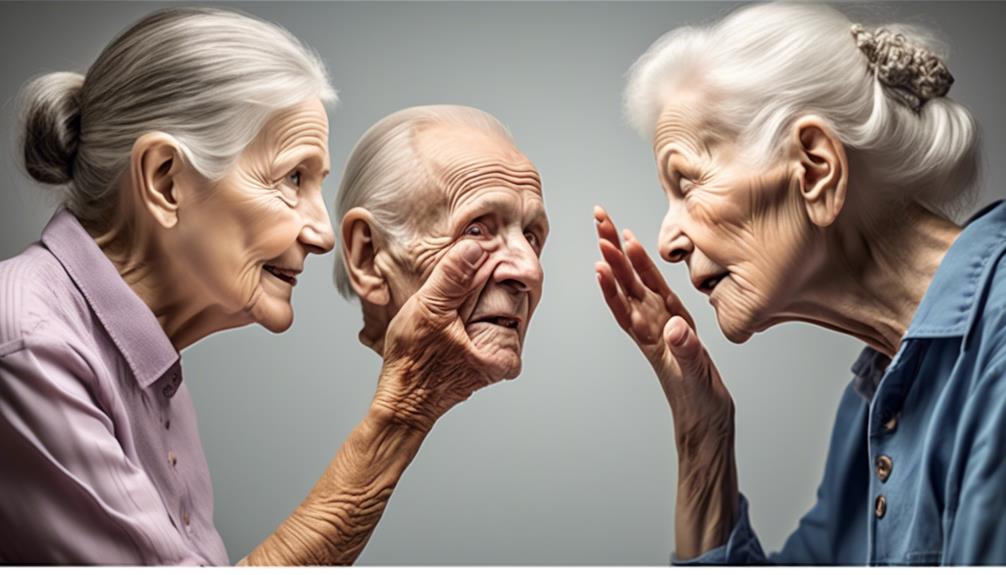Have you ever considered what auditory hallucinations sound like?
The range of sounds that people perceive when experiencing auditory hallucinations is vast and intriguing. From whispers in the wind to booming echoes, these sounds can be as varied as the individuals who hear them.
But what truly defines the auditory landscape of hallucinations, and how do these sounds impact those who experience them?
Let's explore further into the enigmatic world of auditory hallucinations and uncover the complexities that lie within.
Key Takeaways
- Auditory hallucinations can manifest as music, whispers, voices, or indistinct sounds.
- Auditory hallucinations can impact daily life and may require psychological intervention or medical advice.
- Coping mechanisms like grounding techniques and self-care activities can help manage auditory hallucinations.
- Seeking comprehensive evaluation and treatment from healthcare professionals is crucial for auditory hallucinations.
Types of Auditory Hallucinations
In our exploration of auditory hallucinations, it's crucial to understand the various types that individuals may experience. Hearing voices can take on different forms, such as musical hallucinations where one hears songs or melodies that aren't actually playing. Tinnitus, a ringing or buzzing sound in the ears, can also be a type of auditory hallucination that people may encounter.
Command hallucinations involve hearing voices that instruct or command the individual to do something, which can be distressing and unsettling. Additionally, hypervigilance, characterized by heightened sensory awareness, may cause individuals to hear sounds or voices that aren't present in reality. Sometimes, auditory hallucinations can manifest as whispers or murmurs, making it challenging to decipher the words being spoken.
These experiences can vary in frequency, intensity, and volume, impacting individuals differently. Understanding the different types of auditory hallucinations is essential in diagnosing conditions like schizophrenia and addressing associated symptoms effectively.
Common Auditory Hallucination Sounds

Voices speaking, whispering, or shouting are among the common auditory hallucination sounds experienced by individuals. These auditory hallucinations can manifest in various ways, impacting the daily lives of those who hear them.
Here are some common auditory hallucination sounds:
- Voices: Individuals may hear different voices, which can be familiar or unfamiliar, benign, threatening, derogatory, or commanding.
- Music and Melodies: Some may experience auditory hallucinations in the form of music, tunes, or melodies playing in their minds.
- Indistinct Sounds: The sounds heard during auditory hallucinations can be muffled or unclear, making it challenging to comprehend their meaning.
- Repetitive or Looping Sounds: Auditory hallucinations can involve hearing repetitive sounds like songs or phrases on a loop, which can be distressing for the individual.
Understanding these common auditory hallucination sounds is crucial in providing support and care for individuals experiencing such phenomena. Through empathy and knowledge, we can better assist those grappling with the complexities of auditory hallucinations.
Impact of Auditory Hallucinations
Experiencing auditory hallucinations can significantly impact an individual's daily functioning and overall quality of life. These hallucinations, often a sign of mental health conditions, can be distressing and disruptive. Seeking help from a mental health professional is crucial when experiencing auditory hallucinations. Let's delve into the impact of auditory hallucinations through a table highlighting key aspects:
| Aspect | Description |
|---|---|
| Psychological Intervention | Counseling and therapy can help individuals cope with the distress caused by hallucinations. |
| Medical Advice | Seeking medical advice is essential to address any underlying physical or mental health issues contributing to the hallucinations. |
| Brain Stimulation | In some cases, techniques like transcranial magnetic stimulation may be used to alleviate auditory hallucinations. |
Understanding the causes of auditory hallucinations is vital in determining the appropriate treatment. It's essential to remember that timely intervention and support from healthcare professionals can make a significant difference in managing the impact of auditory hallucinations on one's well-being.
Coping Mechanisms for Auditory Hallucinations

To effectively manage auditory hallucinations, individuals can implement various coping mechanisms that promote mental well-being and empower them to navigate distressing experiences. When facing auditory hallucinations, it's essential to employ strategies that help in reducing anxiety and enhancing overall coping abilities. Here are some effective coping mechanisms:
- Practice Grounding Techniques: Utilize deep breathing or mindfulness exercises to stay present and diminish the distress caused by hearing voices.
- Engage in Self-Care Activities: Exercise regularly, maintain adequate sleep, and eat a balanced diet to improve mental well-being and lessen the intensity of auditory hallucinations.
- Develop a Safety Plan: Collaborate with a healthcare provider to create strategies for managing distressing voices, such as contacting a trusted individual or using calming techniques.
- Seek Support from Therapists: Connect with therapists specializing in auditory hallucinations for talk therapy sessions that offer coping strategies and emotional support.
Implementing these coping mechanisms can aid in effectively managing auditory hallucinations and enhancing one's quality of life.
Seeking Help for Auditory Hallucinations
Upon recognizing the significance of managing auditory hallucinations through coping mechanisms, the next crucial step involves seeking help from a healthcare provider for comprehensive evaluation and treatment.
Auditory hallucinations can be a distressing symptom of various underlying causes, including mental disorders or physical conditions like brain tumors. Seeking help is essential in determining the root cause and developing an effective treatment plan.
A healthcare provider may recommend diagnostic tests such as magnetic resonance imaging (MRI) to assess the brain's structure and rule out any physical abnormalities. Treatment options may include antipsychotic medications to alleviate symptoms and behavioral therapy to address the psychological aspects of hearing voices.
Being open and honest with your healthcare provider about the characteristics of the auditory hallucinations and any related symptoms is vital in tailoring the treatment approach. Regular follow-ups are crucial to monitor progress and adjust the treatment plan as needed.
Seeking help is a proactive step towards managing auditory hallucinations and improving overall well-being.
Frequently Asked Questions
How Real Do Auditory Hallucinations Sound?
They can sound incredibly real, making it challenging to distinguish between what's imagined and what's genuine. The voices, tones, and sounds can appear vivid and lifelike, blurring the line between reality and hallucination.
It's a distressing experience that can disrupt daily life, affecting how we perceive our surroundings. The intensity and frequency vary, adding to the complexity of coping with auditory hallucinations.
What Are the Most Common Auditory Hallucinations?
We hear various auditory hallucinations, from whispers to loud bangs, music to indistinct chatter. These sounds can be distressing, interfering with daily life. While some experience clear voices, others hear jumbled noises that are confusing.
Understanding these common auditory hallucinations helps us offer better support to those affected. It's crucial to empathize with individuals experiencing these distressing symptoms and provide appropriate care and resources to manage them effectively.
What Sounds Do Schizophrenics Hear?
When it comes to what sounds schizophrenics hear, the experiences can be varied and intense. These auditory hallucinations may manifest in voices, sounds, or music, and can occur through different channels.
The voices could be positive, negative, or neutral, with varying levels of intensity and frequency. It's essential to understand the complexity of these hallucinations to provide appropriate support and treatment for individuals experiencing them.
What Is an Example of a First Person Auditory Hallucination?
When experiencing a first person auditory hallucination, it can feel like our own inner voice is coming from an external source. These hallucinations, common in conditions like schizophrenia, bipolar disorder, and borderline personality disorder, can range from benign thoughts to distressing messages.
The voice may sound like our own or completely different, offering guidance, advice, or criticism. Such hallucinations can be disruptive, affecting our daily life and well-being.
Conclusion
In the symphony of our minds, auditory hallucinations play a discordant tune. Like a broken instrument in need of repair, these sounds disrupt our inner harmony.
By seeking help and utilizing coping mechanisms, we can work towards tuning out the cacophony and embracing the sweet melody of reality.
Let's not be held captive by the dissonance, but instead strive to orchestrate a life filled with harmony and peace.










